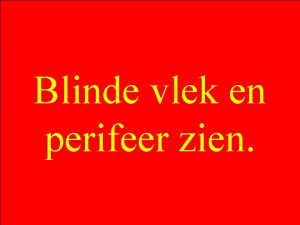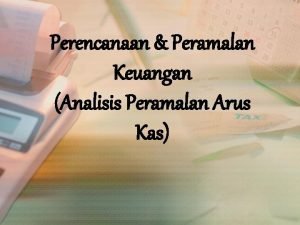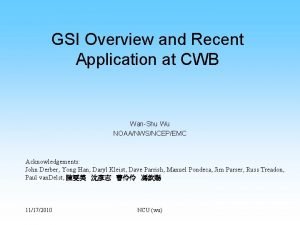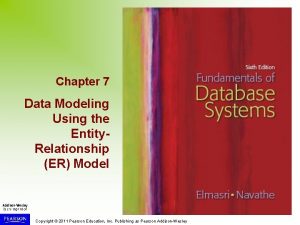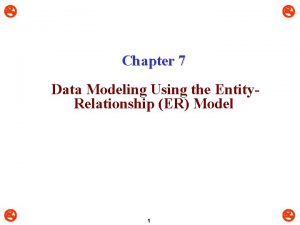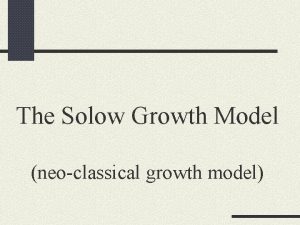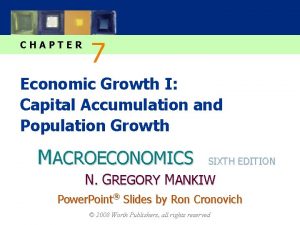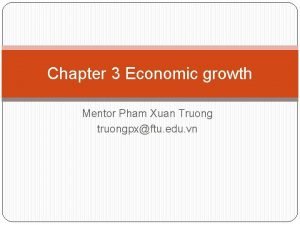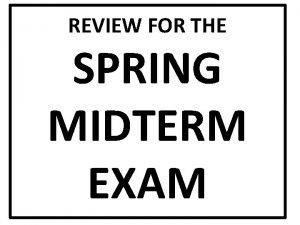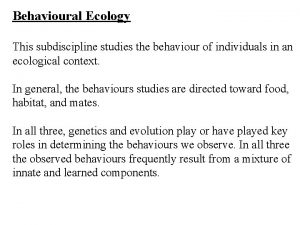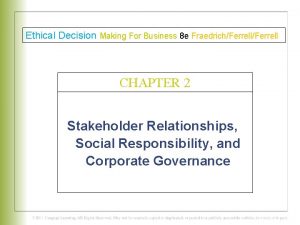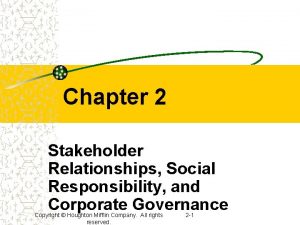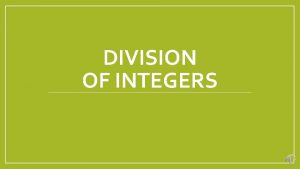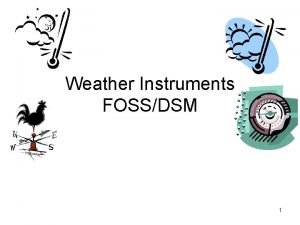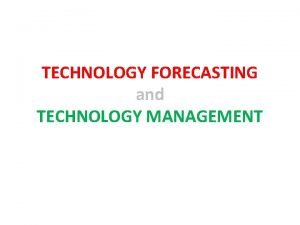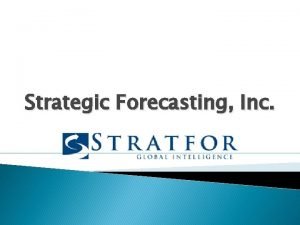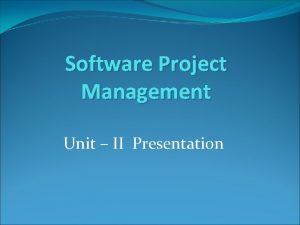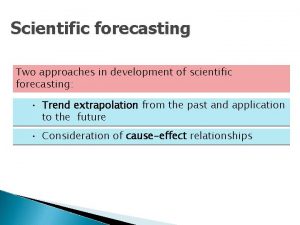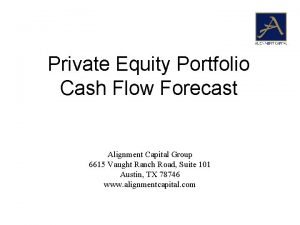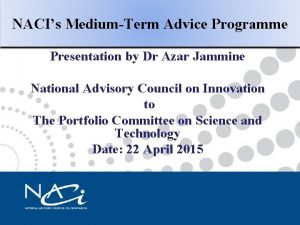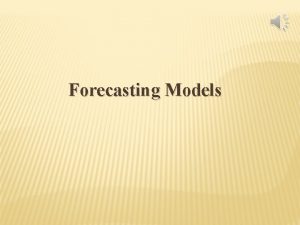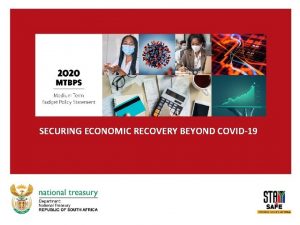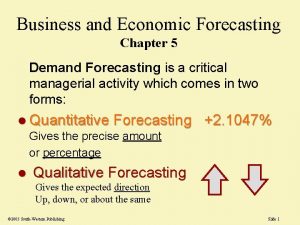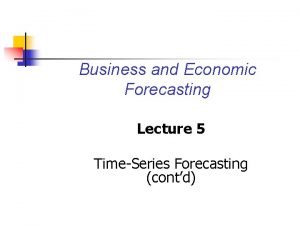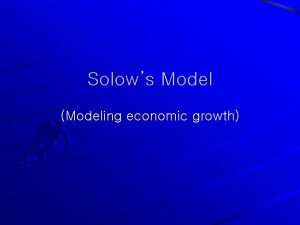Mediumterm forecasting model Jan Vlek Economic Modeling Division


































- Slides: 34

Medium–term forecasting model Jan Vlček Economic Modeling Division jan. vlcek@cnb. cz

OVERVIEW • medium term forecast (MTF) and the model • structure of Quarterly Projection Model (QPM) • responses to typical shocks

MTF - Role of the model • designed to describe interaction of key macrovariables over medium term horizon • provide high level description of forward looking transmission mechanism • what needs to be done to respect the inflation target • provide consistency check on judgements and dynamic of medium term scenario • does not produce forecast - macro models have never been good at forecasting • it‘s staff projection

MTF - Role of the model • simulation tool • provide substantial help on dealing with risks and uncertainty • organizing and disciplining device • comfort in communication • consistency enhance credibility in communication • research tool • model is not designed to reproduce economy in literal sense - two types of model - adaptation process- rates and exchange rate endogenous

MTF - Requirements on model • model has to embody a view on transmission (how monetary policy works, focus debate) • good forecasting tool in medium term horizon • MPC must view model as reflecting the world they deal with • structural approach with economic foundations two types of model • open architecture => ability to incorporate (expert) information from outside the model framework • core model + satellite model tools

MTF - What model needs What we need for model construction • idea about transmission • estimation and calibration • staff and FPAS • near term forecast

Structure of QPM • simple first generation model - key flows • gap model - study the dynamic properties around equilibrium values • semi structural model - equations depict behavior of agent in various markets • no supply side, stocks and assets equilibrium, no stock-flow model • estimation and calibration driven by overall model properties

Structure of QPM Why we start with this first generation model: • insufficient data and experience • participation and communication • little experience with FPAS • the first step on the long way

Structure of QPM • basic logic: – come from model’s purpose – theory of monetary cycle => gap model – two separate blocks • block of long run equilibrium trends • block of cyclical fluctuations • blocks are irreplaceable, they enable us to isolate the key mechanism

Cyclical part of QPM Requirements for the cyclical block: – cyclical part should capture characteristics of Czech economy – IT regime – forward looking transmission mechanism – systematic reaction of interest rate to future inflation deviation from target - focus on medium term deviations – floating exchange rate - endogenous variable

Main cyclical mechanisms in QPM • interaction of supply and demand on markets • inter and intra temporal substitution • behavior of agent influenced by expectations with forward looking component • monetary nature of business cycle: – wage stickiness – final price stickiness – expectation stickiness

Key equations in QPM Crucial parts of QPM • aggregate demand • aggregate supply • exchange rate equation • monetary rule

Output gap Foreign output gap Output gap GDP Persistence Backward expectations Deviations of real interest rate Intra temporal substitution Deviation of real exchange rate International substitution Potential output

Output gap

Inflation of regulated prices Inflation of headline CPI Energy prices inflation Core inflation excluding food Core inflation Inflation of food prices

Core inflation ex. food Forward looking Persistence Backward looking Imported inflation Core Inflation ex. food Behavioral components Relative price movements Business cycle

Core inflation ex. food

Inflation of food prices Forward looking Persistence Food prices Inflation Backward looking Imported inflation Behavioral components Business cycle

Inflation of food prices

Nominal exchange rate Expectational form of UIP Forward looking Expectations Backward looking Nominal exchange rate Interest rate differential

Nominal exchange rate

Interest Rate Rule Policy neutral level of i. r. 3 Month interest rate Equilibrium real rate Inflation expectations Persistence Reaction to business cycle Output gap Expected deviation from target

Interest Rate Rule

Model properties - Calibration versus Estimation • calibrated model, partially estimated • problems with estimation – short data sample – it is not possible to estimate some parameters • calibration - parameters set on the basis of model properties – restriction from economic theory – responses on typical shocks

Model properties - Calibration versus Estimation • adaptive strategy • econometric estimates - limiting guidance • parameters come from theory and behavior in responses Verification • within sample simulation • ‘curve fitting’ estimates

Model properties given by: – model structure – parameters – reaction function verify model properties: – reaction on all possible shocks – simulation experiments

Shock I

Shock II

Shock III

Shock IV

Delayed Policy Response

Policy shock

Way ahead - 1 st, 2 nd and 3 rd Model Generation • First Generation model – – simple gaps model of transmission emphasize on expectations insight on the role of monetary policy starting point, but with useful insights • Second Generation model – C, I, G, X, Q – supply side with stock-flow accounting • Third Generation model – multi sector – fully based on dynamic optimization theory

Thank you for your attention
 Test blinde vlek
Test blinde vlek Helen erickson nursing theory
Helen erickson nursing theory Relational vs dimensional data modeling
Relational vs dimensional data modeling Economic growth vs economic development
Economic growth vs economic development What is economic growth and development
What is economic growth and development Lesson 2 our economic choices
Lesson 2 our economic choices Long division and short division
Long division and short division Synthetic divisin
Synthetic divisin Terms of division
Terms of division Division of polynomials steps
Division of polynomials steps Contoh perencanaan dan peramalan keuangan
Contoh perencanaan dan peramalan keuangan Integrated knowledge sets within an organization
Integrated knowledge sets within an organization Model of hr forecasting
Model of hr forecasting Data modeling using entity relationship model
Data modeling using entity relationship model Er model diagram
Er model diagram Aggregate production function
Aggregate production function Solow model of economic growth
Solow model of economic growth Solow model of economic growth
Solow model of economic growth The economic model
The economic model What is the economic model
What is the economic model Standard economic model
Standard economic model The model is founded in classic economic precepts
The model is founded in classic economic precepts Mrea economic model spreadsheet
Mrea economic model spreadsheet The model is founded in classic economic precepts
The model is founded in classic economic precepts Partition model of division
Partition model of division Chicago multiple nuclei model
Chicago multiple nuclei model Zero based forecasting in hrm
Zero based forecasting in hrm Instruments used in weather forecasting
Instruments used in weather forecasting Color forecasting
Color forecasting Hotel demand forecasting
Hotel demand forecasting Forecasting and management of technology
Forecasting and management of technology Strategic forecasting inc
Strategic forecasting inc Strategic assessment in spm
Strategic assessment in spm The two general approaches to forecasting are
The two general approaches to forecasting are Private equity cash flow forecasting
Private equity cash flow forecasting
